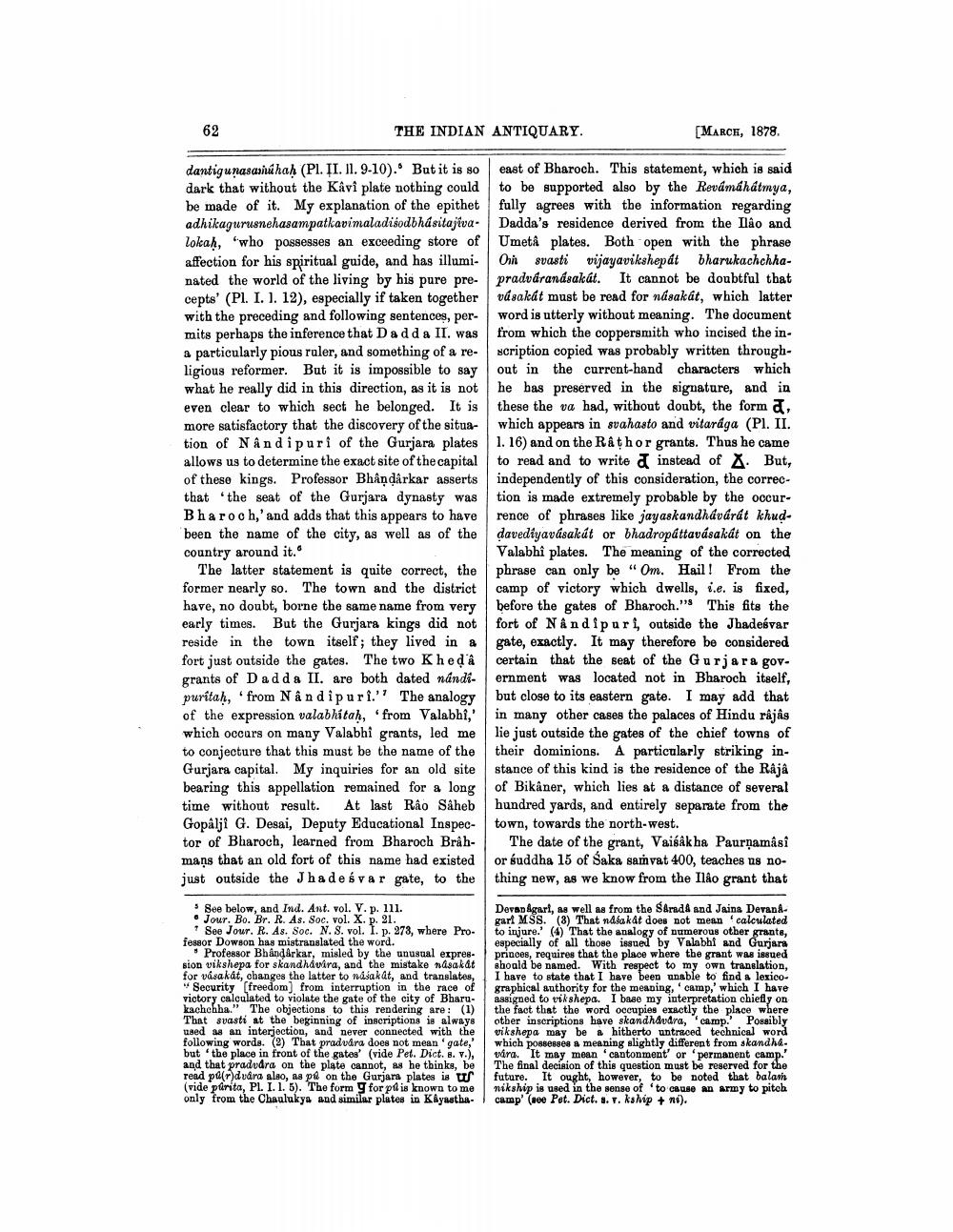________________
62
THE INDIAN ANTIQUARY.
[MARCH, 1878.
dantigunasarahah (P1. II. 11. 9-10). But it is so dark that without the Kåvi plate nothing could be made of it. My explanation of the epithet adhikagurusnehasampatkavimaladisodbhásitajiva- lokah, "who possesses an exceeding store of affection for his spiritual guide, and has illuminated the world of the living by his pure precepts' (Pl. I. 1. 12), especially if taken together with the preceding and following sentences, permits perhaps the inference that Dadda II. was a particularly pious ruler, and something of a re- ligious reformer. But it is impossible to say what he really did in this direction, as it is not even clear to which sect he belonged. It is more satisfactory that the discovery of the situation of Nândipuri of the Gurjara plates allows us to determine the exact site of the capital of these kings. Professor Bhåndarkar asserts that the seat of the Gurjara dynasty was Bharoch,' and adds that this appears to have been the name of the city, as well as of the country around it.
The latter statement is quite correct, the former nearly so. The town and the district have, no doubt, borne the same name from very early times. But the Gurjara kings did not reside in the town itself; they lived in a fort just outside the gates. The two Kheda grants of Dadda II. are both dated nandipuritah, from Nândipuri.'' The analogy of the expression valabhítah, from Valabhi,' which occurs on many Valabhi grants, led me to conjecture that this must be the name of the Gurjara capital. My inquiries for an old site bearing this appellation remained for a long time without result. At last Râo Saheb Gopalji G. Desai, Deputy Educational Inspector of Bharoch, learned from Bharoch Brâhmaņs that an old fort of this name had existed just outside the Jhadeśvar gate, to the
east of Bharoch. This statement, which is said to be supported also by the Revámáhatmya, fully agrees with the information regarding Dadda's residence derived from the Ilâo and Umetå plates. Both open with the phrase On svasti vijayavikshepát bharukachchhapradvárandsakát. It cannot be doubtful that vásakát must be read for násakát, which latter word is utterly without meaning. The document from which the coppersmith who incised the inscription copied was probably written throughout in the current-hand characters which he has preserved in the signature, and in these the va had, without doubt, the form d, which appears in svahasto and vitarága (Pl. II. 1. 16) and on the Rathor grants. Thus he came to read and to write d instead of X. But, independently of this consideration, the correction is made extremely probable by the occur. rence of phrases like jayaskandhávárdt khud. davediyavásakát or bhadropattavásakát on the Valabhî plates. The meaning of the corrected phrase can only be " Om. Hail! From the camp of victory which dwells, i.e. is fixed, before the gates of Bharoch." This fits the fort of Nândipuri, outside the Jhadeśvar gate, exactly. It may therefore be considered certain that the seat of the Gurjara government was located not in Bharoch itself, but close to its eastern gate. I may add that in many other cases the palaces of Hindu râjâs lie just outside the gates of the chief towns of their dominions. A particularly striking instance of this kind is the residence of the Raja of Bikaner, which lies at a distance of several hundred yards, and entirely separate from the town, towards the north-west.
The date of the grant, Vaibak ha Paurņamási or suddha 15 of Saka samvat 400, teaches us nothing new, as we know from the Ildo grant that
See below, and Ind. Ant. vol. V. p. 111. • Jour. Bo. Br. R. As. Soc. vol. X. p. 21.
See Jour. R. As. Soc. N. 8. vol. I. p. 278, where Pro. fessor Dowson has mistranslated the word.
Professor Bhandarkar, misled by the unusual expres. sion vikshepa for skandhavira, and the mistake näsakat for vásakát, changes the latter to nášakat, and translates, "Security (freedom from interruption in the race of victory calculated to violate the gate of the city of Bharukachchha." The objections to this rendering are: (1) That svasti at the beginning of inscriptions is always used as an interjection, and never connected with the following words. (2) That pradvára does not mean "gate,' but the place in front of the gates' (vide Pet. Dict. 8. v.), and that pradvdra on the plate cannot, as he thinks, be read pard vana also, as pa on the Gurjars plates is (vide parita, PL. I. 1. 5). The form 9 for p is known to me only from the Chaulukya and similar plates in Kayastha-
Devangari, as well as from the Sarada and Jaina Devangart MSS. (8) That ndsakåt does not mean calculated to injure.' (4) 'That the analogy of numerous other grante, especially of all those issued by Valabhi and Gurjara princes, requires that the place where the grant was issued should be named. With respect to my own translation, I have to state that I have been unable to find a lexicographical authority for the meaning, camp,' which I have assigned to vikshepa. I base my interpretation chiefly on the fact that the word occupies exactly the place where other inscriptions have skandhaudra, camp. Possibly vikshepa may be a hitherto untraced technical word which possesses a meaning slightly different from akandha: vara. It may mean cantonment or permanent camp.' The final decision of this question must be reserved for the future. It ought, however, to be noted that balanh nikship is used in the sense of 'to cause an army to pitch camp' (see Pet. Dict. s. v. kship + ni).




